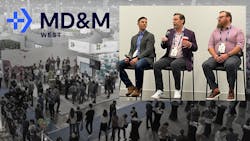While a large amount of the focus in additive manufacturing is about the machines and materials, speakers at the panel discussion on “The Promise of Additive Manufacturing for Production” at the MD&M West trade show in Anaheim on April 13 said there also should be focus on how to gain and maintain control of the 3D printing network.
“It’s not just a hardware solution. You need to have very good on control with your software,” said Matt Karesh of Velo 3D during the panel presentation. “Repeatability, scalability enables true production—not just with a single machine, but in a distributed supply chain.”
The vision of an 3D printing system integrated not just with production but also with supply chain management is part of the promise of additive manufacturing. As speakers noted, the reality of current systems are still a distance from fully realizing thast promise.
“The challenge is convincing people [3D printing] is real,” said Matt Sand of 3DEO. “There have been so many hype cycles to the industry. The important messages is that is it really happening this time. We’re on the precipice of a big breakthrough.”
Added Tim Heller of Stratasys, “Additive doesn’t change the supply chain, it’s a piece of the puzzle.” The size of that puzzle also is a factor, as Heller noted. “When you do analog-to-digital transformation, you ask people to think differently.”
Another consideration is the size of the organization. Because 3D printing depends on CAD model as the single point of reference, that model can be tweaked, replicated and distributed across a local network or distributed around the world.
“You could have a couple of development machines at a centrally located technical center where can vet out components and then, once ready, send the file out to where it needs to be printed,” said Karesh.
“Distributive is where I think we want to go,” said Heller. “If we’re going to talk about distributive, we need to see it’s an enabling device. Right now, it’s not about printing a product; it’s printing a part. There’s a lot more that has to happen end-to-end to get to distributive.”
Speakers speculated that distribution centers also could become a contract manufacturing center, printing parts on-demand rather than carrying inventory waiting for an order. The same model also is possible within a manufacturing plant. Either way, the potential for 3D printing is huge, and early adopters may gain an edge.
“Customers have got to figure out what’s real,” San said. “It’s happening now in a small way that can be hard to see. People are putting a lot of money in quality, in repeatability. People taking advantage of that now are going to have a huge competitive advantage.”
About the Author

Bob Vavra
Editor Emeritus, Machine Design and Power & Motion
Bob Vavra is the former senior content director of Machine Design and Power & Motion.
